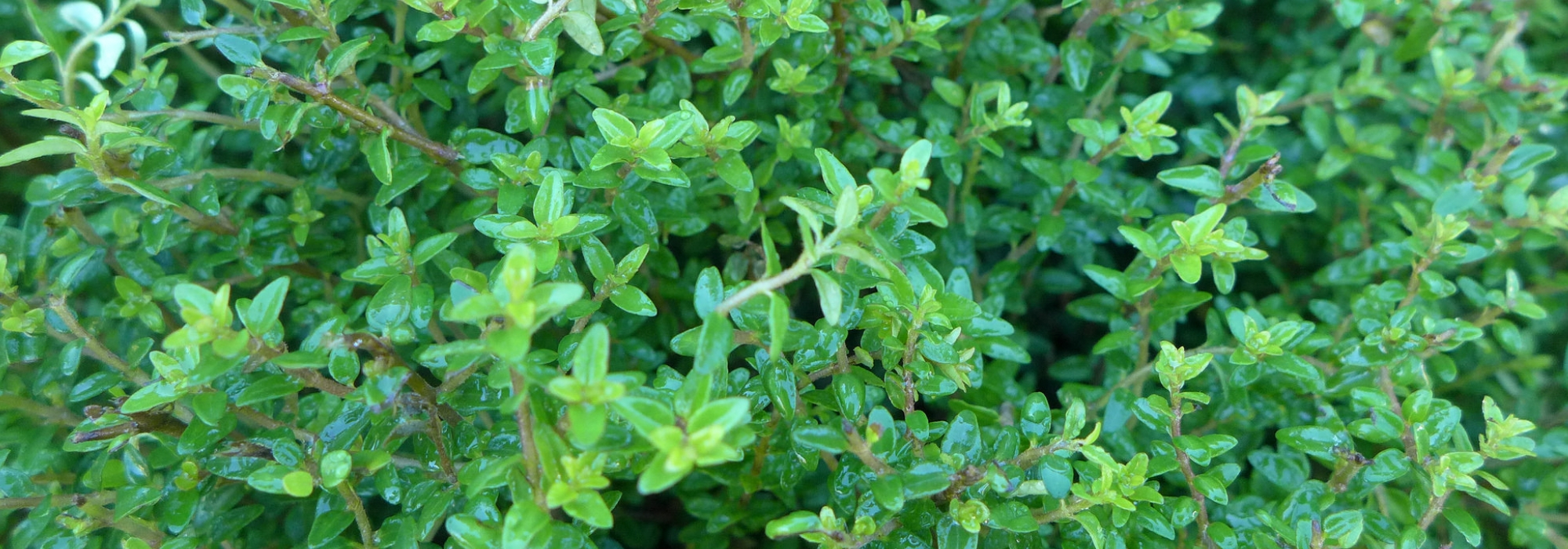
Shrubby honeysuckles, lonicera: planting, pruning and maintaining
Contents
The Shrubby honeysuckle, in a nutshell
- These easy-to-grow bushes are interesting for their small, glossy evergreen leaves, which are sometimes golden or variegated, used in hedges or as ground cover.
- Withstanding repeated pruning very well, the evergreen varieties can be shaped into low hedges and topiary bushes.
- The flowering of bush honeysuckles is often discreet, even insignificant in the case of evergreens, compared to that of climbing honeysuckles, which produce large, highly fragrant flowers.
- A very easy-to-grow and fast-growing bush, the bush honeysuckle helps to structure a garden at little cost.
- Lonicera fragrantissima, the best-known of all, flowers in February-March before the leaves, producing a multitude of extremely fragrant, pearly white flowers.
A word from our expert
Honeysuckles consist of bushes or generally vigorous climbers that wrap around their support with a magnificent flowering that is often highly fragrant. Bush honeysuckles, commonly referred to by the name Lonicera or Honeyberry, are sought after for their dense foliage which is well-suited for hedging or as ground cover, but also for their flowering which, for some deciduous species, diffuses powerful scents in the heart of winter.
They are highly valued for their ease of cultivation and rapid growth, allowing for the establishment of hedges, borders, or ground cover in record time with shoots of 30 to over 40 cm per year. Their slender stems bear opposite, glossy green leaves or those with a velvety appearance, sometimes slightly purplish, and flowers in open tubes with 5 lobes, ranging from white to red, followed by round berries in summer. Notable among evergreens is the Lonicera nitida with small dark green leaves, ideal for forming beautiful, bushy, compact hedges, or the Lonicera periclymenum ‘Chic et Choc’, a dwarf variety with pale pink to orange-yellow flowers suitable for pots or borders. Among deciduous varieties, the Lonicera fragrantissima, semi-trailing, offers a very long flowering of pearly white flowers that are very pleasant to smell in the heart of winter.
Honeysuckles are hardy plants, capable of thriving in the most inhospitable soils as long as the soil is well-drained and cool in sunny situations or preferably in partial shade or even in the shade for the species pileata. Pruning involves shortening the branches just after winter by removing old wood. For hedges, intervention is required two or three times a year. Loniceras are used in borders, hedges, or trained against a wall.
Description and Botany
Botanical data
- Latin name Lonicera (Chamaecerasus)
- Family Caprifoliaceae
- Common name Bush honeysuckle, Honeyberry
- Flowering from July to October
- Height between 0.50 and 3 m
- Exposure sun, partial shade or even shade
- Soil type any soil including calcareous
- Hardiness Excellent (-20 °C and above)
Bush honeysuckles, known by their Latin name Lonicera, form a rather polymorphous genus comprising nearly 180 species widely distributed in the northern hemisphere. Climbing varieties are widely used to adorn trellises or scale walls, while bush varieties with small, generally evergreen leaves are employed to create hedges or ground cover due to their robustness, rapid growth, and longevity. They are excellent substitutes for boxwood, which is currently under threat, although their rapid growth necessitates more frequent pruning.
It would be a shame to overlook bush honeysuckles with deciduous leaves that form vigorous bushes with a fresh lemony scent during the winter months, or the new dwarf variety Chic et Choc, featuring large fragrant pale pink flowers that evolve into orange-yellow, specially developed to bloom in pots or borders in June.
All these bushes exhibit opposite leaves with smooth edges, often lacking petioles. The flowers, generally zygomorphic, present a tube extended by 5 lobes that are highly developed in climbing honeysuckles, much reduced in bush varieties.
The fruits are berries that are generally translucent bright red, purple in Lonicera pileata and nitida, and blue pruinose in edible species such as Lonicera caerulea ssp. kamtchatica, commonly known as Mayberry or Honeyberry (to be discovered in our sheet “Blue honeysuckle, Mayberry”). The nitida species rarely produces fruit due to repeated pruning. The fruits of Loniceras, except for caerulea and edulis species, exhibit low toxicity to humans, causing intestinal disturbances. However, they are appreciated by birds that also find refuge in the intertwined branches.
- Evergreen bush honeysuckles
They mainly consist of two species, Lonicera nitida and pileata, which are available in various cultivars with more or less compact habits and differently coloured foliage.

Some varieties of evergreen bush honeysuckles: Lonicera nitida, Lonicera nitida ‘Baggesen’s Gold’, Lonicera nitida ‘Red Tips’ and Lonicera nitida ‘Lemon Beauty’
Lonicera nitida (syn. Chamaecerasus nitida) is a species from western China, ranging from Yunnan to Sichuan. It is nicknamed the Elegant Honeyberry or Boxwood-leaved honeysuckle because it has rounded leaves measuring 12 mm long, the smallest in the genus. The thin branches form a somewhat shaggy mass after a few weeks following pruning. The long branches covered with tightly packed, shiny, and somewhat leathery foliage arranged in two ranks adopt a trailing habit as if they have been brushed. The cultivar ‘Baggessen’s Gold’ has very bright golden foliage that gives the impression of a vertical green carpet that serves to highlight flower beds. ‘Lemon Beauty’, limited to 1 m high and 1.20 m wide, displays even more brilliant foliage with a dark green hue edged in lemon yellow that tends to blush with the cold.
Lonicera nitida ‘Tidy Tips’ has a ball shape up to 1.20 m in diameter, making it ideal for replacing boxwood balls or forming topiary. The variety ‘Red Tips’ produces charming purple-pink shoots in spring before turning green and adopting bronze hues in autumn, while the variety ‘Silver Beauty’ is sometimes found in undergrowth, in hedges, or sculpted into topiary on a terrace to brighten the scene with its silver appearance. The variety ‘Maigrun’ has a compact spreading habit ideal for ground cover but can reach 1.20 m in all directions.
Lonicera pileata, known as the cup honeysuckle or Privet-leaved honeysuckle, forms a rather spreading evergreen or semi-evergreen shrub that is suitable for both ground cover and Lonicera nitida ‘Maigrün’, as well as for forming a wide low hedge. Its vigorous growth gives it a dense habit that tolerates pruning well. Its elongated triangular leaves, measuring 1 to 3 cm long, are well distributed in two ranks along the thin branches, displaying a beautiful glossy appearance that produces a lush effect, especially in shaded areas. Low maintenance, it forms an excellent ground cover without any upkeep if one wishes to avoid pruning. Another quality is its small, round, shiny intense purple fruits that dot its foliage in autumn.
- Deciduous bush honeysuckles
Lonicera fragrantissima forms a large shrub, up to 2.50 m high, whose oval leaves persist in mild climates. Its bell-shaped cream-white flowers are arranged in clusters along glabrous caramel-coloured branches and remain from December to March, diffusing a delightful lemony fragrance that delights bumblebees. Lonicera x purpusii ‘Winter Beauty’, a cross between fragrantissima and standishii, offers equally fragrant flowers tinged with purple-pink at opening on slightly pubescent branches. These shrubs tolerate pruning very well, which should be done after flowering and are suitable for all soils. However, they need a warm summer to produce the maximum number of buds that open successively at each cluster. To flower your interiors, cut a few branches that will finish blooming in a vase.
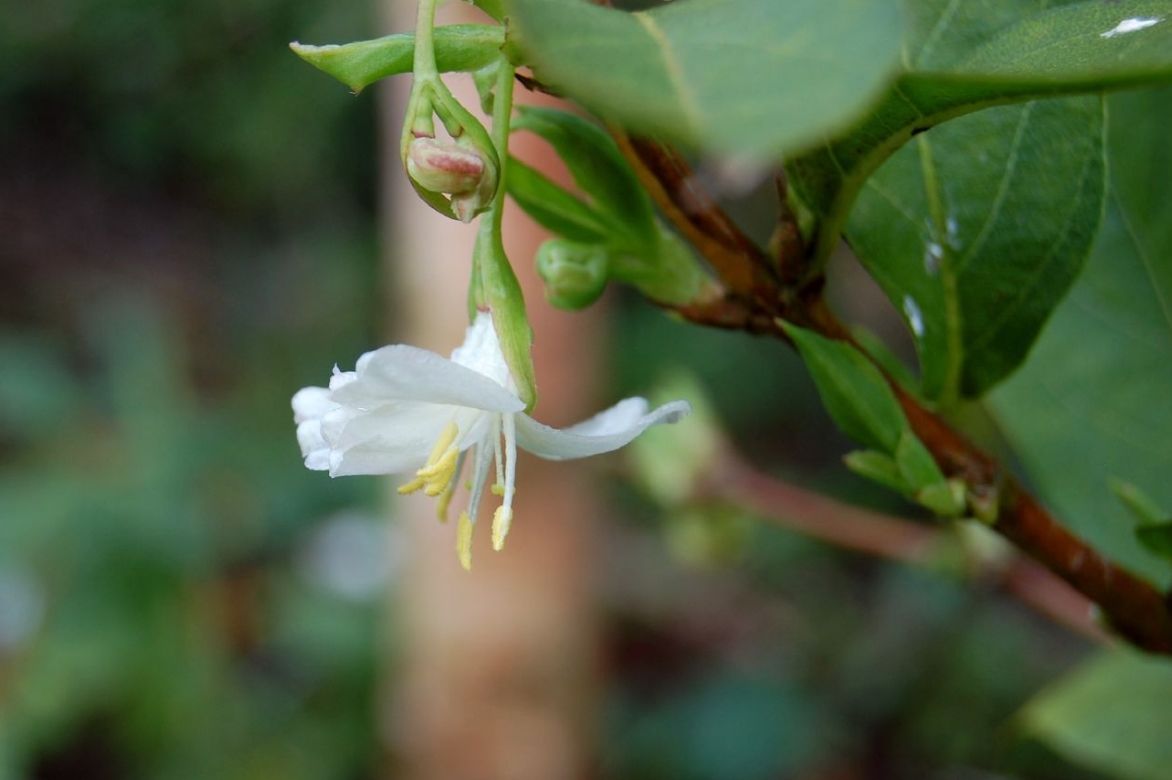
Winter flowering, fragrant and melliferous of Lonicera fragrantissima (photo Brockvicky)
The Tatarian honeysuckle, Lonicera tatarica, suffers from a lack of recognition of the genus as it produces abundant pinkish-purple flowers, reddish-purple in ‘Hack’s Red’. This bush, native to the Caucasus, has fairly large leaves of intense green with a bluish underside, on which a multitude of small, somewhat irregular (zygomorphic) flowers stand out, with a tube extended by 5 petals. The 5 orange stamens illuminate the inside of the petals, which are slightly lighter than the outside.
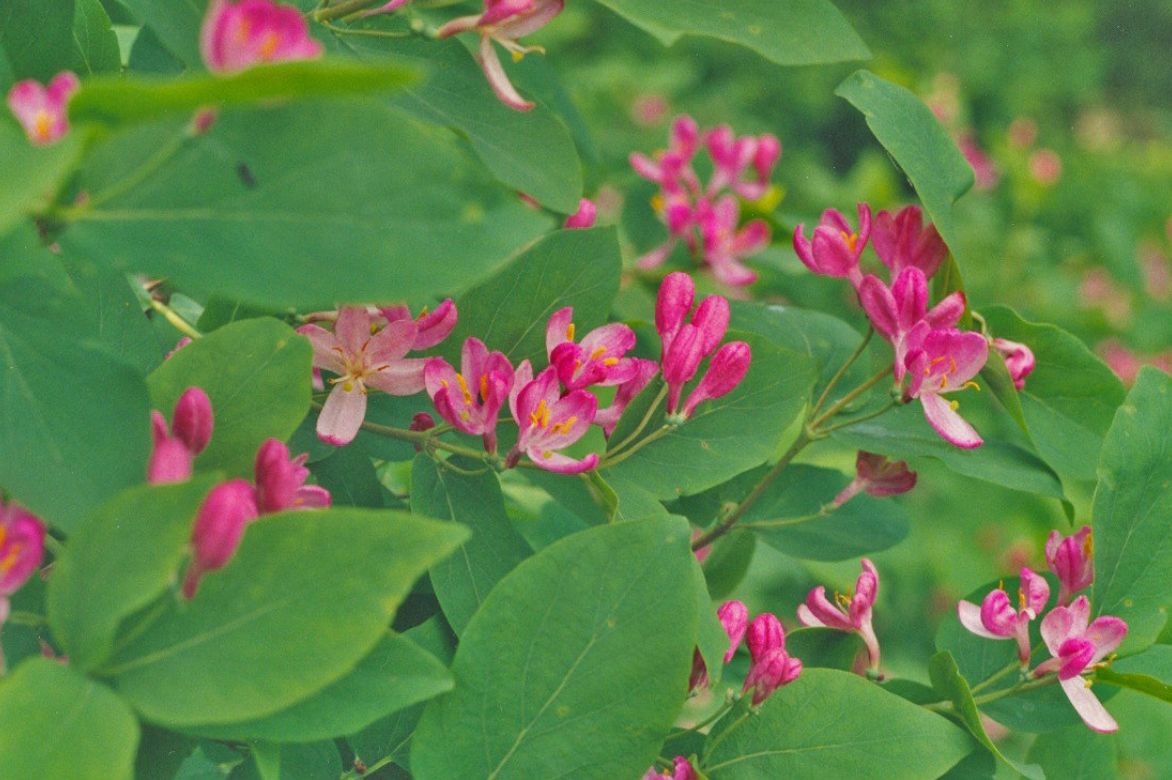
Delicious pinkish-purple flowers of Lonicera tatarica ‘Hack’s Red’, unjustly overlooked
The main varieties of Shrubby Honeysuckle
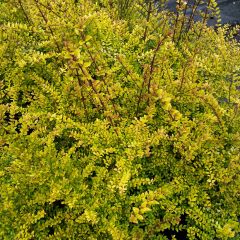
Lonicera nitida Baggesens Gold - Box Honeysuckle
- Flowering time May, June
- Height at maturity 1,50 m
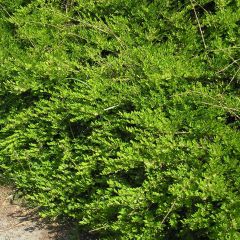
Lonicera pileata - Box Honeysuckle
- Flowering time May, June
- Height at maturity 70 cm

Lonicera nitida Silver Beauty - Box Honeysuckle
- Flowering time May, June
- Height at maturity 1 m

Lonicera nitida Red Tips - Box Honeysuckle
- Flowering time May, June
- Height at maturity 1,25 m
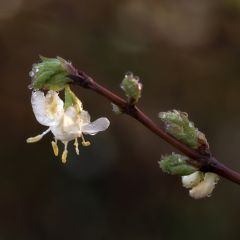
Lonicera x purpusii Winter Beauty
- Height at maturity 2 m
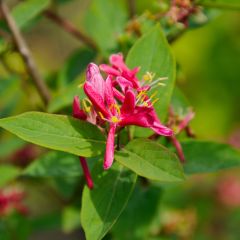
Lonicera tatarica Hacks Red - Tatarian Honeysuckle
- Flowering time May to July
- Height at maturity 2,50 m
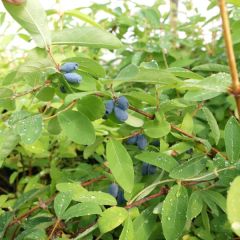
Lonicera kamtschatica Kalinka - Honeyberry
- Flowering time March to June
- Height at maturity 1,20 m
Discover other Honeysuckle
View all →Available in 2 sizes
Available in 1 sizes
Available in 1 sizes
Available in 2 sizes
Available in 1 sizes
Available in 1 sizes
Available in 2 sizes
Available in 3 sizes
Available in 1 sizes
Available in 1 sizes
Planting
Where to plant shrubby honeysuckles?
Evergreen honeysuckles can be planted in both light sun and partial shade, even in complete shade, such as Lonicera pileata. Choose a spot that is fully sunny in winter for deciduous honeysuckles like tatarica and fragrantissima, to increase the number of flowers and attract pollinators. Their considerable height, reaching up to 2.50 m, encourages planting them at the back of a border or as a hedge, but remember to leave easy access to enjoy their fragrance up close and to cut a few branches for indoor arrangements.
Very easy to grow, they truly accept all types of soil, including calcareous, from dry to moist (without being waterlogged), as well as polluted soils and air pollution.
When to plant?
In containers, these honeysuckles can be planted at any time, except during the height of summer when watering requires more attention.
How to plant?
Here’s how to plant a shrubby honeysuckle:
- Soak the root ball in a bucket of water to thoroughly moisten it.
- Dig a hole three times wider than the root ball and loosen the soil around it with a fork. To form a hedge or a dense mat of Lonicera pileata or nitida, space the plants 60 to 80 cm apart.
- Add some compost if the soil is poor.
- Place the plant in the planting hole.
- Replace the soil and lightly firm it down.
- Water.
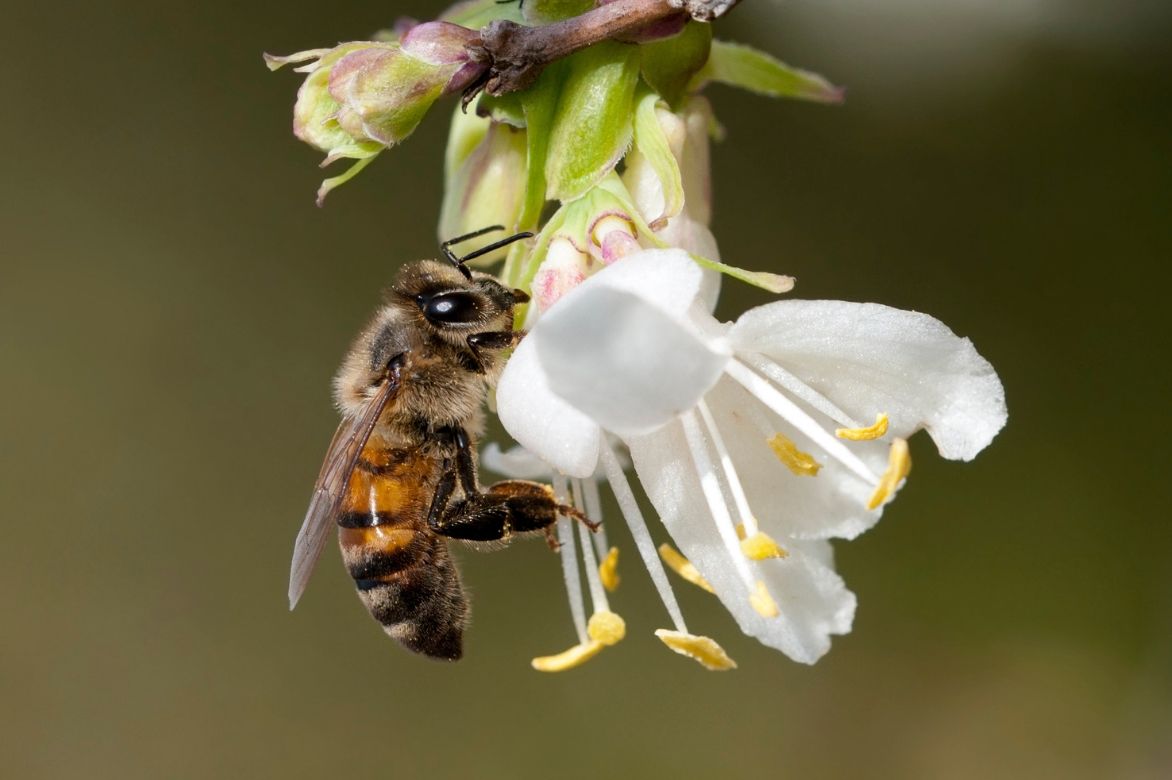
The flowers of winter honeysuckle are highly appreciated by pollinating insects
Pruning and maintenance of honeysuckle
Water regularly in the first and second year following planting to ensure good establishment.
Carry out any pruning after flowering on flowering honeysuckles and 2 to 3 times a year, in April and September for the nitida. The frequency of pruning mainly depends on the level of tidiness desired for the plant, whether it is a topiary or a more free-form undulation that can be given to a slope planted with Lonicera pileata.
These honeysuckles are very resistant to diseases and pests.
Multiplication : propagation by cuttings
The simplest method of propagation is to layer the low stems or to propagate the Lonicera in August-September.
Propagation by Cuttings
Prepare a deep pot by filling it with potting soil mixed with sand, or carry out your cuttings directly in a nursery.
- Take well-lignified shoot tips that are 10-15 cm long.
- Remove the soft part at the tip and eliminate the leaves near the base of the cutting.
- Insert the cuttings into the pot ensuring they do not touch each other.
- Gently firm the soil around to eliminate air pockets and ensure good contact between the potting soil and the cutting.
- Place them in a humid environment in the shade under a frame at 18°C, for example, by placing a cut transparent plastic bottle over them.
- In autumn, separate the rooted cuttings and plant them in buckets, keeping them under the frame until spring.
- Plant your young plants in spring in the open ground.
Uses and associations
Shrubby honeysuckles like the elegant honeysuckle (Lonicera nitida) are ideal plants for creating a neutral backdrop in borders, offering a regular and delicate texture due to the small size of the leaves. With a free habit, they make perfect candidates for country hedges interspersed with flowering or ornamental fruiting shrubs such as Deutzia, Mock Orange, Weigela, Callicarpa, Cornus mas, and fragrant honeysuckles or tatarica, etc. The small whitish flowers of nitida, in May-June, are pleasantly scented and contribute to the dance of foraging insects. Birds appreciate it as both a refuge and a food source due to the abundance of its small bright violet berries, which are absent when the shrub is pruned too often! It can also grow freely in a woodland, adopting a lovely weeping form that eventually creates a carpet at its base thanks to the layering of its arching branches.
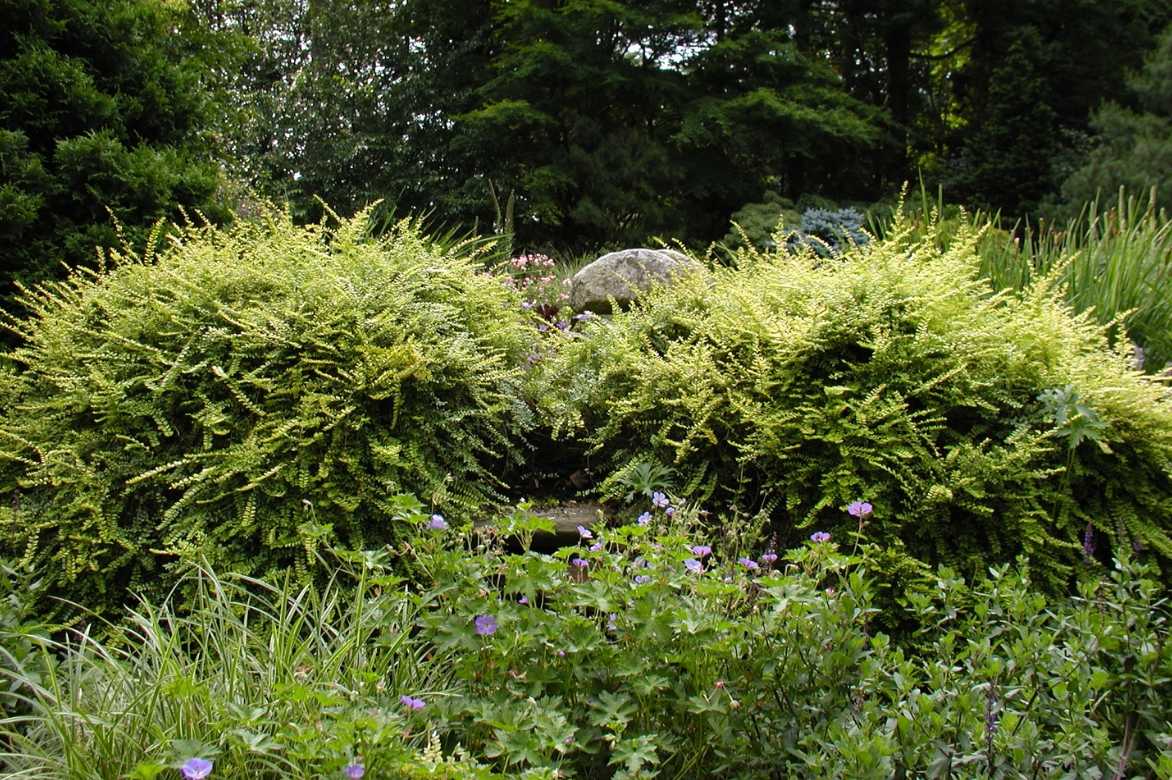
Lonicera nitida in the garden setting
The golden box-leaved honeysuckle ‘Baggesen’s Gold’, slightly less vigorous than the type, is very useful for creating low to medium-height hedges (1.20 to 1.50 m) in partially shaded situations. It offers an interesting alternative to boxwood as its growth is faster and its foliage is light and bright. It lends itself well to topiary and can be placed in a container on a terrace. You can also train it against a trellis and plant colourful bulbs or perennials at its base. The Lonicera nitida ‘Tidy Tips’ can form original sculptures with its young purple-pink shoots or be trained.
The cup honeysuckle (pileata) is very useful for stabilising a slope in poor soil and can create undulations according to your inspiration. With its low habit, it is also suitable for highlighting large rockeries, alongside other ground-cover plants such as creeping roses (Rosa ‘Grouse’, Rosa ‘Gloucestershire’, Rosa ‘The Fairy’ or ‘Little White Pet’), golden Lonicera nitida, fortunei euonymus, creeping conifers like blue juniper (Juniperus squamata ‘Blue Carpet’), rockery conifers (Thuya occidentalis ‘Rheingold’), a false jasmine (Trachelospermum jasminoides), or halliana honeysuckle (Lonicera halliana), a climber that you can let run through the gaps.
To go further
Discover our range of Shrubby honeysuckles
Our advice sheet: How to choose a shrubby honeysuckle?
- Subscribe!
- Contents
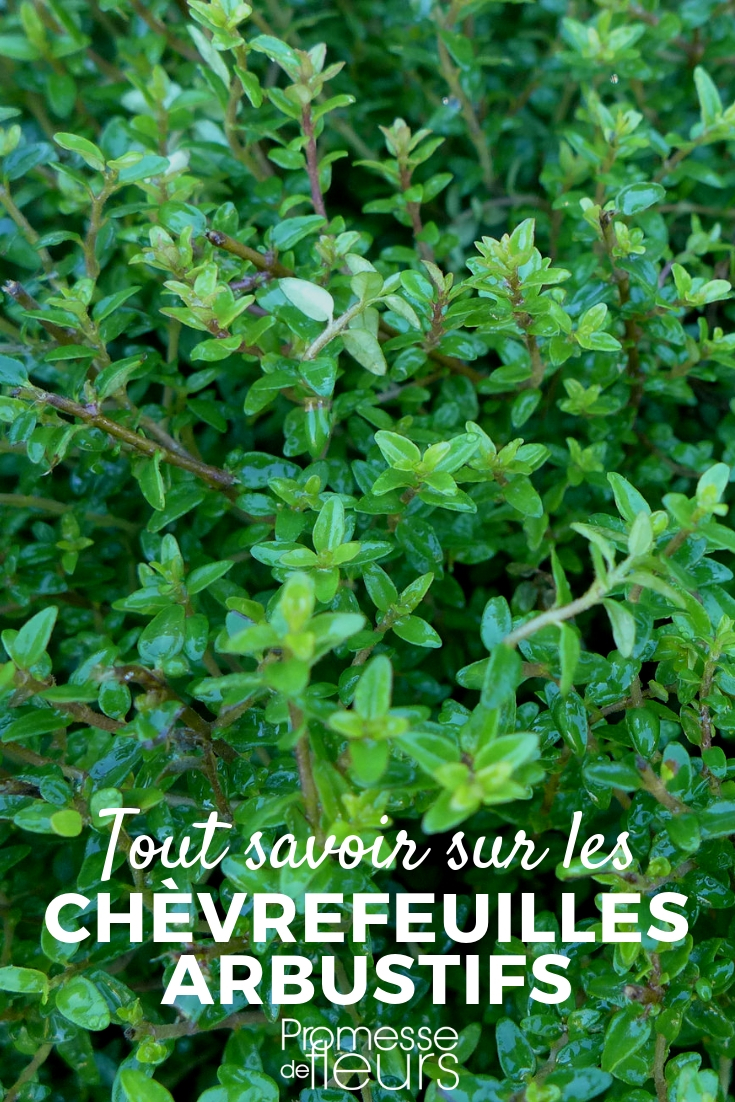































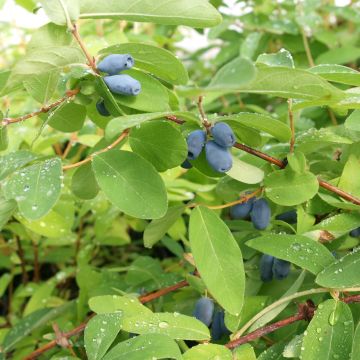
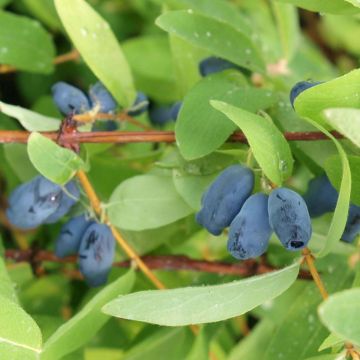

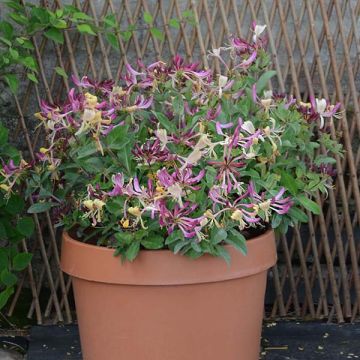

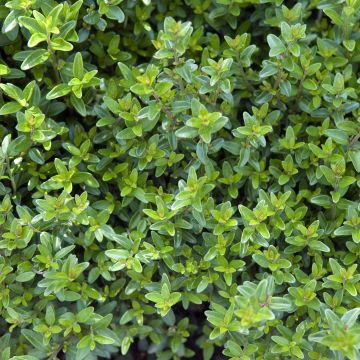
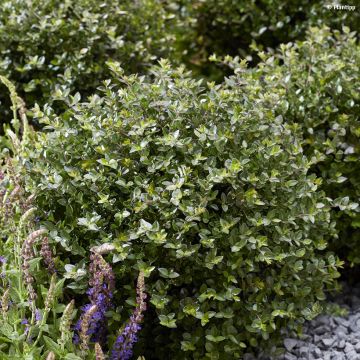
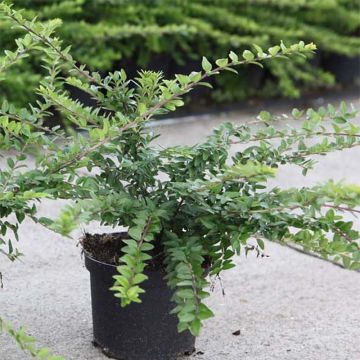
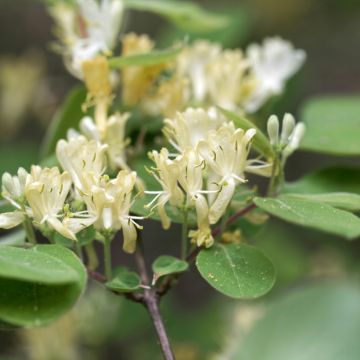
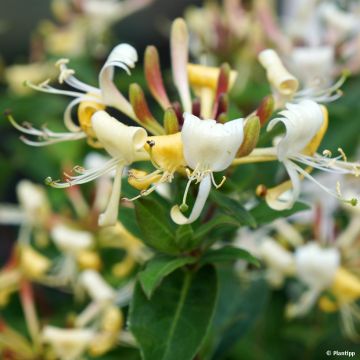
Comments